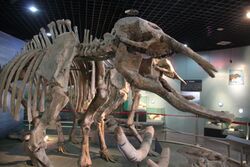Biology:Tetralophodon
| Tetralophodon | |
|---|---|

| |
| Mounted skeleton, Henan Geological Museum | |
| Scientific classification | |
| Domain: | Eukaryota |
| Kingdom: | Animalia |
| Phylum: | Chordata |
| Class: | Mammalia |
| Order: | Proboscidea |
| Superfamily: | Elephantoidea |
| Genus: | †Tetralophodon Falconer, 1857 |
| Species | |
Tetralophodon ("four-ridged tooth") is an extinct genus of "tetralophodont gomphothere" belonging to the superfamily Elephantoidea, known from the Miocene of Afro-Eurasia.[2][3][4]
Taxonomy and evolution
The genus Tetralophodon (meaning "four-ridged tooth") was named in the mid-19th century with the discovery of the specialized teeth.
Tetralophodon is suggested to have descended from the "trilophodont gomphothere" Gomphotherium. "Tetralophodont gomphotheres" like Tetralophodon are thought to be ancestral to elephantids and stegodontids,[5] with African species of Tetralophodon suggested to be the ancestor of elephantids.[6] Tetralophodon is also suggested to be the ancestor of the fellow "tetralophodont gomphothere" Anancus.[7]
Description

A large individual of the European species T. longirostris is suggested to have been 3.45 metres (11.3 ft) tall at the shoulder and up to 10 tonnes in weight.[8] The first and second molar teeth are tetralophodont (bearing four pairs of cusps).[9] The mandibular symphysis of the lower jaw is typically elongate and bears lower tusks. The lower tusks vary greatly in size and morphology between species, with some species having flattened tusks with an oval-shaped cross section, while others have tusks which are pyriform (pear-shaped) in cross section.[10][11] The upper tusks are proportionally large,[9] and lack enamel bands.[11]
Distribution

These animals were very widespread and successful proboscideans. Their fossils have been found from the Middle Miocene to the Late Miocene epochs of Europe, Asia, and Africa.[9] The likely oldest species in the genus, the European T. longirostris first appeared around 13-12.5 million years ago.[12] The North American species, T. campester and T. fricki, were moved to the genus Pediolophodon in 2007, which is suggested to be unrelated to Tetralophodon, but instead represtenting parallel evolution.[13]
Ecology
Specimens of Tetralophodon from the late Miocene of East Africa have been suggested to be browsers and mixed feeders based on mesowear analysis. Analysis of tooth wear suggest that these individuals had developed proal movement (back to front motion) in the lower jaws, akin to that used by modern elephants, but different from that used by earlier gomphotheres.[14]Note: This topic belongs to "Paleontology" portal
References
- ↑ Shi-Qi Wang; Haruo Saegusa; Jaroon Duangkrayom; Wen He; Shan-Qin Chen (2017). "A new species of Tetralophodon from the Linxia Basin and the biostratigraphic significance of tetralophodont gomphotheres from the Upper Miocene of northern China". Palaeoworld. in press. doi:10.1016/j.palwor.2017.03.005
- ↑ J. Shoshani and P. Tassy. 2005. Advances in proboscidean taxonomy & classification, anatomy & physiology, and ecology & behavior. Quaternary International 126-128:5-20
- ↑ J. Shoshani and P. Tassy. 1996. Summary, conclusions, and a glimpse into the future. in J. Shoshani and P. Tassy, eds., The Proboscidea: Evolution and Palaeoecology of Elephants and Their Relatives 335-348
- ↑ Mothé D, Ferretti MP, Avilla LS (2016) "The Dance of Tusks: Rediscovery of Lower Incisors in the Pan-American Proboscidean Cuvieronius hyodon Revises Incisor Evolution in Elephantimorpha". PLoS ONE 11(1): e0147009. doi:10.1371/journal.pone.0147009
- ↑ Wu, Yan; Deng, Tao; Hu, Yaowu; Ma, Jiao; Zhou, Xinying; Mao, Limi; Zhang, Hanwen; Ye, Jie et al. (2018-05-16). "A grazing Gomphotherium in Middle Miocene Central Asia, 10 million years prior to the origin of the Elephantidae" (in en). Scientific Reports 8 (1): 7640. doi:10.1038/s41598-018-25909-4. ISSN 2045-2322. PMID 29769581. Bibcode: 2018NatSR...8.7640W.
- ↑ Geraads, Denis; Zouhri, Samir; Markov, Georgi N. (2019-05-04). "The first Tetralophodon (Mammalia, Proboscidea) cranium from Africa" (in en). Journal of Vertebrate Paleontology 39 (3): e1632321. doi:10.1080/02724634.2019.1632321. ISSN 0272-4634. Bibcode: 2019JVPal..39E2321G. https://www.tandfonline.com/doi/full/10.1080/02724634.2019.1632321.
- ↑ Romano, Marco; Bellucci, Luca; Antonelli, Matteo; Manucci, Fabio; Palombo, Maria Rita (2023-06-13). "Body mass estimate of Anancus arvernensis (Croizet and Jobert 1828): comparison of the regression and volumetric methods" (in en). Journal of Quaternary Science 38 (8): 1357–1381. doi:10.1002/jqs.3549. ISSN 0267-8179. Bibcode: 2023JQS....38.1357R. https://onlinelibrary.wiley.com/doi/10.1002/jqs.3549.
- ↑ Larramendi, A. (2016). "Shoulder height, body mass and shape of proboscideans". Acta Palaeontologica Polonica 61. doi:10.4202/app.00136.2014. https://www.app.pan.pl/archive/published/app61/app001362014.pdf.
- ↑ 9.0 9.1 9.2 van der Made, J. The Evolution of the Elephants and Their Relatives in the Context of Changing Climate and Geography. In Elefantentreich—Eine Fossilwelt in Europa; Verlag Beier & Beran: Langenweißbach, Germany, 2010; pp. 340–360. ISBN 978-3-939414-48-3.
- ↑ Wang, Shi-Qi; Saegusa, Haruo; Duangkrayom, Jaroon; He, Wen; Chen, Shan-Qin (December 2017). "A new species of Tetralophodon from the Linxia Basin and the biostratigraphic significance of tetralophodont gomphotheres from the Upper Miocene of northern China" (in en). Palaeoworld 26 (4): 703–717. doi:10.1016/j.palwor.2017.03.005. https://linkinghub.elsevier.com/retrieve/pii/S1871174X16301366.
- ↑ 11.0 11.1 Konidaris, George E.; Tsoukala, Evangelia (2022), Vlachos, Evangelos, ed., "The Fossil Record of the Neogene Proboscidea (Mammalia) in Greece" (in en), Fossil Vertebrates of Greece Vol. 1 (Cham: Springer International Publishing): pp. 299–344, doi:10.1007/978-3-030-68398-6_12, ISBN 978-3-030-68397-9, https://link.springer.com/10.1007/978-3-030-68398-6_12, retrieved 2023-08-29
- ↑ Sanders, William J. (2023-07-07) (in en). Evolution and Fossil Record of African Proboscidea (1 ed.). Boca Raton: CRC Press. pp. 163. doi:10.1201/b20016. ISBN 978-1-315-11891-8. https://www.taylorfrancis.com/books/9781315118918.
- ↑ Lambert, W. D. (2007). "New tetralophodont gomphothere material from Nebraska and its implications for the status of North American Tetralophodon". Journal of Vertebrate Paleontology 27 (3): 676–682. doi:10.1671/0272-4634(2007)27[676:NTGMFN2.0.CO;2].
- ↑ Saarinen, Juha; Lister, Adrian M. (2023-08-14). "Fluctuating climate and dietary innovation drove ratcheted evolution of proboscidean dental traits" (in en). Nature Ecology & Evolution 7 (9): 1490–1502. doi:10.1038/s41559-023-02151-4. ISSN 2397-334X. Bibcode: 2023NatEE...7.1490S.
Wikidata ☰ Q1955654 entry
 |

